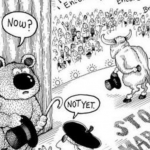What transformative development that each of us takes very much for granted involved each of these seemingly non-correlated elements:
1) Novel vision
2) Determination to overcome these seemingly insurmountable obstacles:
- Bureaucracy
- Differences between New York and Chicago
- Railroad inertia (later in its history)
3) A synergy of new technology
4) Smoking
Stumped?
I imagine that for most of us, the fortieth anniversary of a uniquely “Chicago” innovation went mostly unnoticed – the birth of the Chicago Board Options Exchange (CBOE) on April 26, 1973. That was the inaugural day of options trading – with 911 call options (on just 16 stocks) being available for interested options traders. The CBOE was the very first options exchange in the world, and since 1973, at least forty-nine other options exchanges have been started around the world.
Because those of us in 2013 have taken options trading for granted for so many years, and because we have become completely accustomed to trading options from office, home, or even a smartphone – it is difficult to imagine just how innovative options were forty years ago. It is also difficult to appreciate how tenacious the early options “pioneers” had to be in order to (eventually) bring their dream to reality.
How long do you suppose it took Joe Sullivan (the founding president of CBOE) and his colleagues to create the world’s first options exchange: six months, one year, eighteen months, two years, three years, or three and one-half years?
IMAGE: The image to the left shows Joe Sullivan celebrating a CBOE anniversary in its early years. Joe is the cake cutter. (Image from CBOE website).
The correct answer is “none of the above”. The time span between the concept of a system through which to trade options (that concept took root in the late 1960’s) and the official opening of the CBOE took four and one-half years! The genesis of the options exchange concept came from within the existing Chicago Board of Trade (CBOT)– which was heavily dependent upon agriculture (the largest volume of futures contracts traded through it were grains, crops, livestock, etc.). Because it was so agriculture-centric, the CBOT realized it needed a means of diversifying its business and revenue stream.
Key CBOT leaders authorized work to be started in efforts to secure authorization for the trading of options on securities. That set Joe Sullivan and his team on an incredible roller coaster of conversations, negotiations, brick walls, and herculean efforts to break down those walls.
From the start, the CBOT envisioned this “new business” being created within the CBOT as an integral part of its open outcry system of trading (in the “trading pits”). However, once the U.S. Securities and Exchange Commission (SEC) got wind of these efforts to trade options on securities (stocks) – it asserted its own overriding control over that bailiwick and insisted that it be the regulator through whom the CBOT must work to secure official sanction for an options exchange.
Although not surprising to us in 2013, that development was a huge “momentum killer” for the CBOT. Leaders and members of the CBOT wanted absolutely nothing to do with the SEC! And on its part, the SEC was (to put it mildly) unenthusiastic about Sullivan’s idea. At the first meeting of Sullivan with the SEC staff assigned to handle Sullivan’s request, the senior staff member said (paraphrasing): “There are absolutely insurmountable obstacles to the options exchange idea so you shouldn’t waste a nickel on it!”
To Sullivan’s enduring credit, he didn’t take “no” for an answer. He and his associates kept working through each obstacle and impediment until, over four years later, SEC approval and Federal Reserve System approval had been secured!
The first months of CBOE took place within an unorthodox – but very affordable – “trading floor”: the “smoking lounge” of the CBOT! In addition, the trading was recorded and cleared through computer software that was created and provided at practically no cost! (For all of you born after the acceleration of computer technology – it is absolutely essential to know that the computing technology used back in the 60’s and 70’s was (putting it mildly) “primitive”. The 1968 Data General “Nova” computer ($8,000) had just 32 kilobytes of memory; the first “PC” (1971) the “Kenbak 1” had 256 byte memory; the first “Apple” was not created until 1976).
History is replete with unplanned “synergies” that converge to ensure the success of developing trends. A vital “synergy” that is central within the history of the CBOE was the publication (almost coincident with the exchange’s birth) of the “Black-Scholes” options pricing model. That development was crucial for the same reason that light is essential for empowering us to wend our way safely through a room in the dead of night – that is, the ability to “see” where we are and where we are headed. That Nobel prize winning model enabled traders to attach an empirically determined “value” on any given option, which was important because, until “Black-Scholes” (according to current CBOE CEO, Bill Brodsky): “No one really knew what an option was worth. It was just merely supply and demand.”
IMAGE: The image to the left recognizes the extremely significant role that the Nobel Prize winning Black-Scholes Model has played in the success of the CBOE. (Image from the CBOE website).
According to Adam Warner, whose father was a market maker in the 1970’s, early options trading was (by our standards) extremely simplistic: “They didn’t shop orders or anything, so I imagine prices were all over the board. Plus, they only listed options every three months, so you’d go awhile between expirations!” Contrast that with today’s options world. During each of the past two years, over 4 billion options have traded hands on approximately 3,500 underlying instruments!
The history of the CBOE is far too full of fascinating details and “turns” to adequately record here. However, it is worth mentioning some key landmarks within the forty-year life of the CBOE:
1975: introduction of computerized price reporting; the creation of the Options Clearing House (OCC), through which all U.S. options are now cleared.
1977: “Put” options are introduced (yes, it took three years, and lots of political arm-twisting).
IMAGE: The creation and development of hand-held computers (such as the TI 30 pictured to the left) were an immense boon to the confidence option traders had on the CBOE floor. (Image from the CBOE website).
1983: Options are created on two broad-based stock indexes: S&P 100 (OEX) and S&P 500 (SPX).
1989: Options on interest rates begin trading.
1990: Long-Term Equity AnticiPation Securities (LEAPS) are created… with expirations of up to three years.
1993: The CBOE Volatility Index (VIX) is created; Flexible Exchange (FLEX) options are introduced (customizable terms, etc.).
1997: First options on Dow Jones Industrial Average (DJX).
2002: CBOE S&P BuyWrite Index (BXM) – first major benchmark to track performance based on an options strategy.
2005: “Weeklys” are introduced; first one week options are in SPX and OEX.
2008: CBOE passes a milestone on annual volume: over 1 Billion contracts!
2013: European customers receive a new “London Hub”; CBOE works on launching of 24 hour/5 days (each week) trading on VIX futures.
In future weeks, I’ll lift up a few more key ways that the CBOE has transformed the trading world during the past 40 years. Needless to say, the countless trading vehicles we now take for granted would not have evolved as quickly or successfully as they did were it not for the indomitable spirit and tenacious efforts of Joe Sullivan (pictured in the foreground of the image to the right) and the many folks who helped him conquer bureaucratic inertia and institutional jealousies to create and grow the CBOE!
If you want to find out more details, take a few minutes to soak up the boatload of anecdotes and fascinating tidbits available at:
http://www.cboeoptionshub.com/cboe40/#.UYQOieCbppY
http://www.cboe.com/aboutcboe/History.aspx
Submitted by Thomas Petty
Related Posts
Also on Market Tamer…
Follow Us on Facebook

 Can XRP Overtake Bitcoin?
Can XRP Overtake Bitcoin?



